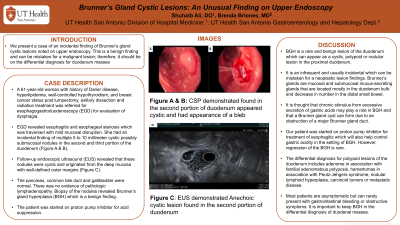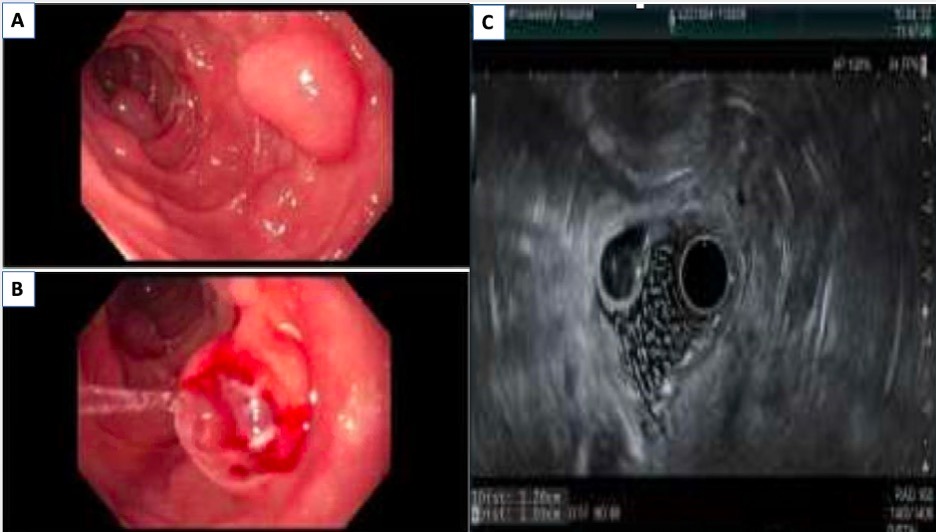Monday Poster Session
Category: Small Intestine
P2702 - Brunner’s Gland Cystic Lesions: An Unusual Finding on Upper Endoscopy
Monday, October 23, 2023
10:30 AM - 4:15 PM PT
Location: Exhibit Hall

Has Audio
- SA
Shuhaib Ali, MD
UT Health San Antonio
San Antonio, TX
Presenting Author(s)
Shuhaib Ali, MD1, Farah Ladak, MD2, Brenda Briones, MD3
1UT Health San Antonio, San Antonio, TX; 2UTHSCSA, San Antonio, TX; 3University of Texas Health Science Center at San Antonio, San Antonio, TX
Introduction: We present a case of an incidental finding of Brunner’s gland cystic lesions noted on upper endoscopy. This is a benign finding and can be mistaken for a malignant lesion; therefore, it should be on the differential diagnosis for duodenum masses.
Case Description/Methods: A 61-year-old woman with history of Darier disease, hyperlipidemia, well-controlled hypothyroidism, and breast cancer status post lumpectomy, axillary dissection and radiation treatment was referred for esophagogastroduodenoscopy (EGD) for evaluation of dysphagia. EGD revealed esophagitis and esophageal stenosis which was traversed with mild mucosal disruption. She had an incidental finding of multiple 5 to 10 millimeter cystic possibly submucosal nodules in the second and third portion of the duodenum (Figure A & B). Follow-up endoscopic ultrasound (EUS) revealed that these nodules were cystic and originated from the deep mucosa with well-defined outer margins (Figure C). The pancreas, common bile duct and gallbladder were normal. There was no evidence of pathologic lymphadenopathy. Biopsy of the nodules revealed Brunner’s gland hyperplasia (BGH) which is a benign finding. The patient was started on proton pump inhibitor for acid suppression.
Discussion: BGH is a rare and benign lesion of the duodenum which can appear as a cystic, polypoid or nodular lesion in the proximal duodenum. It is an infrequent and usually incidental finding which can be mistaken for a neoplastic lesion. Brunner’s glands are mucosal and submucosal mucus-secreting glands that are located mostly in the duodenum bulb and decrease in number in the distal small bowel. It is thought that chronic stimulus from excessive secretion of gastric acids may play a role in BGH and that a Brunner gland cyst can form due to an obstruction of a major Brunner gland duct. Our patient was started on proton pump inhibitor for treatment of esophagitis which will also help control gastric acidity in the setting of BGH. However, regression of the BGH is rare. The differential diagnosis for polypoid lesions of the duodenum includes adenoma in association with familial adenomatous polyposis, hamartomas in association with Peutz-Jehgers syndrome, nodular lymphoid hyperplasia, carcinoid tumors or metastatic disease. Most patients are asymptomatic but can rarely present with gastrointestinal bleeding or obstructive symptoms. It is important to keep BGH in the differential diagnosis of duodenal masses.

Disclosures:
Shuhaib Ali, MD1, Farah Ladak, MD2, Brenda Briones, MD3. P2702 - Brunner’s Gland Cystic Lesions: An Unusual Finding on Upper Endoscopy, ACG 2023 Annual Scientific Meeting Abstracts. Vancouver, BC, Canada: American College of Gastroenterology.
1UT Health San Antonio, San Antonio, TX; 2UTHSCSA, San Antonio, TX; 3University of Texas Health Science Center at San Antonio, San Antonio, TX
Introduction: We present a case of an incidental finding of Brunner’s gland cystic lesions noted on upper endoscopy. This is a benign finding and can be mistaken for a malignant lesion; therefore, it should be on the differential diagnosis for duodenum masses.
Case Description/Methods: A 61-year-old woman with history of Darier disease, hyperlipidemia, well-controlled hypothyroidism, and breast cancer status post lumpectomy, axillary dissection and radiation treatment was referred for esophagogastroduodenoscopy (EGD) for evaluation of dysphagia. EGD revealed esophagitis and esophageal stenosis which was traversed with mild mucosal disruption. She had an incidental finding of multiple 5 to 10 millimeter cystic possibly submucosal nodules in the second and third portion of the duodenum (Figure A & B). Follow-up endoscopic ultrasound (EUS) revealed that these nodules were cystic and originated from the deep mucosa with well-defined outer margins (Figure C). The pancreas, common bile duct and gallbladder were normal. There was no evidence of pathologic lymphadenopathy. Biopsy of the nodules revealed Brunner’s gland hyperplasia (BGH) which is a benign finding. The patient was started on proton pump inhibitor for acid suppression.
Discussion: BGH is a rare and benign lesion of the duodenum which can appear as a cystic, polypoid or nodular lesion in the proximal duodenum. It is an infrequent and usually incidental finding which can be mistaken for a neoplastic lesion. Brunner’s glands are mucosal and submucosal mucus-secreting glands that are located mostly in the duodenum bulb and decrease in number in the distal small bowel. It is thought that chronic stimulus from excessive secretion of gastric acids may play a role in BGH and that a Brunner gland cyst can form due to an obstruction of a major Brunner gland duct. Our patient was started on proton pump inhibitor for treatment of esophagitis which will also help control gastric acidity in the setting of BGH. However, regression of the BGH is rare. The differential diagnosis for polypoid lesions of the duodenum includes adenoma in association with familial adenomatous polyposis, hamartomas in association with Peutz-Jehgers syndrome, nodular lymphoid hyperplasia, carcinoid tumors or metastatic disease. Most patients are asymptomatic but can rarely present with gastrointestinal bleeding or obstructive symptoms. It is important to keep BGH in the differential diagnosis of duodenal masses.

Figure: A & B.CSP demonstrated found in the second portion of duodenum appeared cystic and had appearance of a bleb
C. EUS demonstrated Anechoic cystic lesion found in the second portion of duodenum
C. EUS demonstrated Anechoic cystic lesion found in the second portion of duodenum
Disclosures:
Shuhaib Ali indicated no relevant financial relationships.
Farah Ladak indicated no relevant financial relationships.
Brenda Briones indicated no relevant financial relationships.
Shuhaib Ali, MD1, Farah Ladak, MD2, Brenda Briones, MD3. P2702 - Brunner’s Gland Cystic Lesions: An Unusual Finding on Upper Endoscopy, ACG 2023 Annual Scientific Meeting Abstracts. Vancouver, BC, Canada: American College of Gastroenterology.
